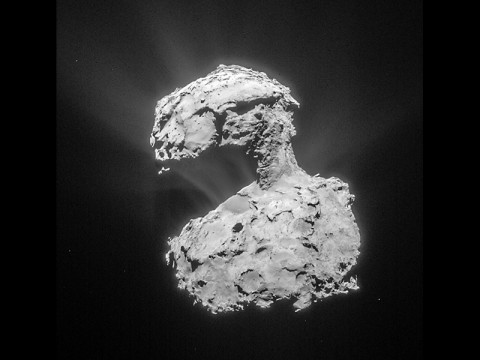Written by DC Agle
NASA’s Jet Propulsion Laboratory
 Pasadena, CA – Since last September, scientists using NASA’s Microwave Instrument for Rosetta Orbiter (MIRO) on the European Space Agency’s Rosetta spacecraft have generated maps of the distribution of water in the coma of comet 67P/Churyumov-Gerasimenko, as the comet’s orbit brings it closer to the sun.
Pasadena, CA – Since last September, scientists using NASA’s Microwave Instrument for Rosetta Orbiter (MIRO) on the European Space Agency’s Rosetta spacecraft have generated maps of the distribution of water in the coma of comet 67P/Churyumov-Gerasimenko, as the comet’s orbit brings it closer to the sun.
MIRO is able to detect water in the coma by measuring the direct emission from water vapor in the coma and by observing absorption of radiation from the nucleus at water-specific frequencies as the radiation passed through the coma.

In this narrow region, the number of water molecules is up to two orders of magnitude higher than elsewhere in the coma. Lower but still substantial amounts of water were detected over on the day side of the nucleus up to the terminator between the illuminated and dark side. The lowest amounts of water are found on the comet’s night side — particularly over its southern polar regions.
This could be due to either local outgassing or circulation effects within the coma, causing water to flow from the day to the night side.
The MIRO instrument is a small and lightweight spectrometer that can map the abundance, temperature and velocity of cometary water vapor and other molecules that the nucleus releases. It can also measure the temperature up to about one inch (two centimeters) below the surface of the comet’s nucleus.
One reason the subsurface temperature is important is that the observed gases likely come from sublimating ices beneath the surface. By combining information on both the gas and the subsurface, MIRO is able to study this process in detail.
Comets are time capsules containing primitive material left over from the epoch when the sun and its planets formed. Rosetta is the first spacecraft to witness at close proximity how a comet changes as it is subjected to the increasing intensity of the sun’s radiation. Observations will help scientists learn more about the origin and evolution of our solar system and the role comets may have played in seeding Earth with water, and perhaps even life.
Rosetta is an ESA mission with contributions from its member states and NASA. Rosetta’s Philae lander is provided by a consortium led by the German Aerospace Center, Cologne; Max Planck Institute for Solar System Research, Gottingen; French National Space Agency, Paris; and the Italian Space Agency, Rome. NASA’s Jet Propulsion Laboratory, Pasadena, California, a division of the California Institute of Technology in Pasadena, manages the U.S. contribution of the Rosetta mission for NASA’s Science Mission Directorate in Washington.
JPL also built the MIRO and hosts its principal investigator, Samuel Gulkis. The Southwest Research Institute (San Antonio and Boulder), developed the Rosetta orbiter’s IES and Alice instruments, and hosts their principal investigators, James Burch (IES) and Alan Stern (Alice).
A European Space Agency blog post on the MIRO data is online at:
For a deeper dive into the science the blog post is based on, please visit:
http://www.aanda.org/component/article/?access=doi&doi=10.1051/0004-6361/201526094
For more information on the U.S. instruments aboard Rosetta, visit:
http://rosetta.jpl.nasa.gov
More information about Rosetta is available at:
http://www.esa.int/rosetta


